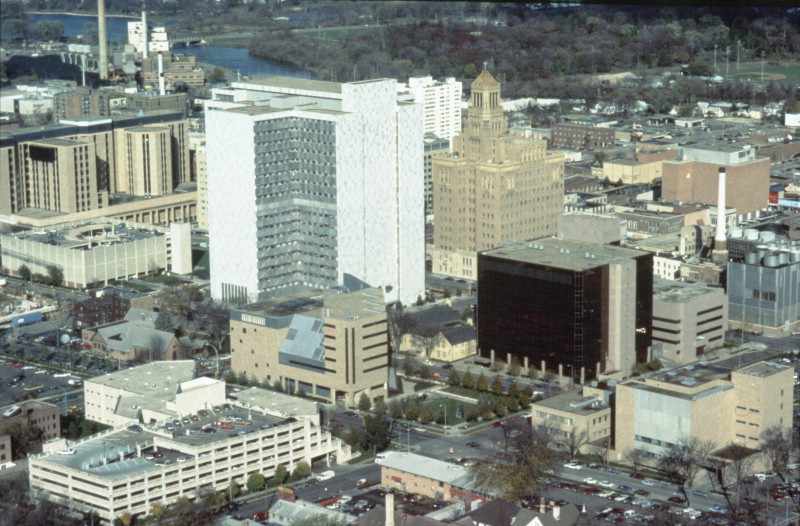-
#ThrowbackThursday: New Mayo Clinics and the Decision to Expand Outside Rochester

This article first appeared June 1984 in the publication Mayovox.
Last month the Board of Trustees approved plans for Mayo to begin development of new Mayo Clinic group practices at distant sites. In the following interview, Dr. W. Eugene Mayberry, chairman of the Board of Governors, explains the thinking behind this decision and some of its implications.
Why are we expanding outside of Rochester?

The rationale for expanding outside of Rochester encompasses several points. One is an altruistic reason. We have a sincere belief that we have a unique model for health care delivery here that has served people well. We feel we can be of even greater service to the public by extending our system beyond the reaches of this region.
Another point is the need for the institution to grow. We’ve always grown since our inception and growth has allowed us to be of a size to justify having all the necessary components of a tertiary, highly specialized national health care resource. We need to continue to grow in order to create new services, such as liver transplantation. If we don’t grow, anytime we provide a new service we would have to eliminate an existing service and that is very difficult. We need to grow to provide the programs in education and research that we have traditionally provided. And we need to grow because we don’t know how not to grow. We don’t have any experience in that.
Other reasons for expanding are related to changes ocurring in health care in America. Health care is increasingly going to be provided by large institutions, multi-system institutions. We think Mayo Clinic is the best poised institution in the United States to lead a physician-directed, multi-system practice of medicine in the United States.
Another reason is that HMO’s and insurance systems are increasingly restricting patients from coming to Rochester. You only have to look at Canada for an example of what could happen. The number of patients coming to us from Canada is only a quarter of what it used to be because of the restrictions of its National Health System.
We are also motivated by the fact that population growth in the Midwest, which is where we derive the majority of our patients, is not projected to grow or to grow only slightly. If we are going to grow and expand our services, then we are going to have to look to the growth areas in the Sun Belt and not expect those patients always to come to Rochester.
Do you think the Mayo model is exportable? Will it work in another location?
I am convinced that it can. I think in every location it is going to be a little bit different, but I think there are certain basic ingredients that are exportable. One is our strong concern for the individual patient and treating the individual patient with dignity and compassion. Then there are our beliefs that the patient comes first and that in order to provide the very best in patient care you have to have significant programs in education and research. Also, I think the systems that have evolved here to help us care for patients efficiently could enhance the practice of medicine in any integrated group practice.
One of the things that we’ve worried most about in going elsewhere is finding paramedical people like we have here. The people of southeastern Minnesota, northern Iowa and western Wisconsin have been a top quality resource for us—they have helped make Mayo what it is. We worry that in other locations we will not be able to attract or have access to the same caliber of individuals. But I am convinced that given the goals and ideals of the institution and the influence of Mayo people on the scene, we can overcome any differences that may exist originally.
How many satellites are planned and where will they be located?
We hope that in a number of years we will have many satellites, but obviously we don’t have resources to start too many at once. We’re planning on starting two or three initially. And I think the most likely locations of those will be in the Sun Belt. The exact locations are not decided as of yet.
How will the locations be chosen?
We will look at needs, at the presence or absence of group practices, at the growth of those areas, and the potential for future growth. We will look at the possibility of hospital affiliations, at marketing surveys and at the quality of life at various locations.
How big would these facilities be?
The plan is that each location would have about 20 physicians to start. And hopefully they would grow rather rapidly from that point on.
Will the satellite facilities have similar physical facilities and practice arrangements as in Rochester?
They will probably differ depending upon the needs of each community being served. But the physical facilities will be top-notch. We want the physical facilities to say to the community in which they are placed that this is the Mayo Clinic and we have arrived. In general, the systems and arrangements for practice will be patterned along the Mayo Clinic-Rochester lines, although obviously a 20-person group is quite different than one involving 850 individuals.
Who would staff these facilities?
The nucleus would be experienced Mayo Clinic staff consultants, with some recruitment from our residency programs. Some Mayo trained individuals from these locations might also be invited to join us.
How about paramedical people—are there going to be opportunities for them, too?
Very definitely. We want to inculcate the ideals, goals and attitudes of the Mayo Clinic-Rochester in these Mayo group practices in other locations and our paramedical forces would be an integral and very important aspect of that.
What sort of connections would there be between Mayo Clinic-Rochester and the satellites?
There would be many cross appointments between Mayo Clinic-Rochester and the group practices. We envision the possibility that in slack times such as late winter some of our Rochester staff might help staff the warm weather facilities and, alternatively, in the summer some Sun Belt facilities might transfer staff back to Rochester.
We would also plan to have telecommunications systems available for communicating between these facilities and Rochester. In the early stages these facilities are not going to have the depth, especially of expertise, that exists in Rochester—so we would hope to augment their capabilities through telecommunications. These systems would also be used for educational programs.
Ultimately we envision a Mayo group practice division that would be an integral part of an umbrella organization—Mayo Foundation. Each clinic would have its own leadership and each would have representation on a board of governors of the Mayo group practice division and on the umbrella organization-Mayo Foundation Board of Trustees.
Do you expect the satellites to refer many patients to Mayo-Rochester?
I think they would be self-contained for all the primary care and most of the secondary care but a lot of the more complex tertiary patients I expect would be referred to Rochester. Presently relatively few of our patients come from the Sun Belt. So I don’t think the satellites will reduce the flow of patients to Rochester. Rather I think they will increase our tertiary care referrals here. Plus it’s going to make those regions more aware of the Mayo Clinic and the large facility that exists here in Rochester.
Do you think Mayo will be welcomed in these new locations?
It depends on what group you are talking about. I think there is no doubt that the citizens of the communities in which we choose to locate are going to find that we will be a real asset and they are going to welcome us warmly. There is no question that the medical communities are not going to be pleased to have us because of competitive forces. Hospitals that we might affiliate with, I think, will be pleased to have us there because hospitals nationally have occupancy problems and to have a Mayo group practice close by would be desirable to those hospitals with low occupancies.
Is there any timetable for development of these satellites?
We’re already working very vigorously on plans right now. We are hoping that we will have two to three clinics functioning by 1986-87.
Does Mayo have enough funds to finance these new operations?
Given a reduced rate of growth in Rochester –1½ % per year as compared to around 3-5% per year as it has been in recent years—we have enough money in hand to initiate a few new clinics, with the proviso that in short order they become self-sustaining. If growth is very rapid in these locations we might need to borrow money in order to do all that we want to do.
You talked about reduced growth in Rochester. What does that mean for some of the building projects that have been talked about?
The projects that we have announced are going to go forward. The parking ramp is already in progress, we are rapidly making plans for Mayo Clinic North adjacent to the Methodist Hospital. The timetable, I think, for new facilities on the Damon block is in question depending upon the demand for growth in Rochester. And on growth in Rochester, I would like to emphasize that we intend to do everything we can to continue to stimulate the kind of programs and activities that will result in continued growth in Rochester on the order of 1½ percent per year.
Do you see any significant obstacles standing in the way of these expansion plans?
Competition might have some impact, the number of physicians out there. Another problem is licensure for experienced physicians that we might want to move from Rochester to another location. But I don’t see any overwhelming obstacles to these ventures being a very great success. I am so optimistic that we have something here that other regions would benefit from and that will appeal to them, that I just can’t conceive that we are not going to be very successful. We intend to make them so.







